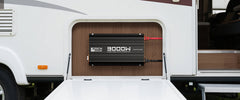
What Size Inverter Do You Need? A Complete Guide for Home, RV & Off-Grid Systems
, 8 Tiempo mínimo de lectura


, 8 Tiempo mínimo de lectura
Choosing the right inverter size is crucial—too small, and your appliances won’t work; too large, and you’ll waste money. This guide will help you determine the ideal inverter size for your specific needs, whether for home backup, RV living, or off-grid solar power.
An inverter converts DC power (from batteries or solar panels) into AC power (for household appliances). Picking the wrong size can lead to:
* By the end of this guide, you’ll know exactly which inverter fits your setup.
Inverter size is measured in watts (W) and depends on two key specs:
|
Term |
Definition |
Why It Matters |
Example |
|
Continuous Power |
Stable power output |
Determines what you can run long-term |
A 2000W inverter can power a 1500W microwave continuously |
|
Surge Power |
Short-term peak (3-5 sec) |
Needed for motor startup (fridge, AC, tools) |
A fridge may need 3x its running wattage to start |
* Important: Your inverter must cover both the total running watts of all devices plus the highest surge wattage of any single appliance.
Include:
Home: Fridge, lights, TV, microwave, AC
RV: Air conditioner, induction cooktop, water pump
Off-Grid: Well pump, power tools, medical devices
* Pro Tip: Use a Kill-A-Watt meter to measure actual consumption.
Find the running watts (on the label or manual)
Note surge watts for motors (fridge, AC, pumps)
|
Device |
Running Watts |
Surge Watts |
|
Refrigerator |
600W |
1800W |
|
LED TV |
100W |
- |
|
Microwave |
1000W |
- |
|
Air Conditioner (10K BTU) |
1500W |
4500W |
Formula:
Inverter Size = (Total Running Watts × 1.2) + Highest Surge Watts
Example:
* Safety Margin: Always add 20-30% extra for efficiency losses and future expansion.
|
Scenario |
Recommended Inverter Size |
Sample Load |
|
Emergency backup (fridge + lights) |
1500W-2000W |
Fridge, phone charger, LED lights |
|
Partial home (essentials) |
3000W-5000W |
Refrigerator, lights, TV, microwave |
|
Whole-house backup |
8000W-12,000W |
AC, well pump, electric stove |
*Tip: If you're powering your entire home, consider using a transfer switch for safety and convenience.
|
RV Size |
Recommended Inverter |
|
Small campers (no AC) |
1000W-2000W |
|
Mid-size RVs (with AC) |
3000W-5000W |
|
Large RVs (full-time living) |
5000W+ |
Recommended models:
* Lithium batteries handle surge loads better than lead-acid—important for RVs running multiple appliances.
* For larger off-grid homes or cabins, inverters in the 3000W–6000W range are common.
|
Feature |
Pure Sine Wave |
Modified Sine Wave |
|
Compatibility |
Works with all devices (sensitive electronics, motors) |
May damage some appliances |
|
Efficiency |
90-95% |
75-85% |
|
Cost |
More expensive |
Cheaper |
When to Choose Pure Sine Wave:
When Modified Sine Wave Might Work:
12V: Best for small systems (<2000W)
24V: Ideal for RVs and mid-size solar (2000W-4000W)
48V: Most efficient for large off-grid systems (4000W+)
High-efficiency inverters (≥90%) waste less power
Low standby drain (<10W) saves battery when idle
Ventilation: Keep 6+ inches clearance
Wiring: Use thick cables (4 AWG for 2000W @ 12V)
Consider features like remote control, LCDs, or smart monitoring.
|
Mistake |
Solution |
|
❌ Underestimating surge watts |
✅ Check startup wattage for fridges, A/C, etc. |
|
❌ No buffer for future needs |
✅ Add 20–30% extra capacity |
|
❌ Incompatible battery system |
✅ Match the inverter voltage to the battery bank |
|
❌ Skipping pure sine wave |
✅ Use it for any sensitive or motor-based devices |
✅ Made a list of all devices
✅ Calculated running + surge watts
✅ Added 20-30% safety margin
✅ Chosen pure sine wave if needed
✅ Matched DC voltage with your battery bank
Choosing the right inverter size ensures reliable power, longer battery life, and cost savings. Follow this guide, and you’ll avoid costly mistakes.
Reach out to us for personalized help.
Chat with an expert for a free recommendation.